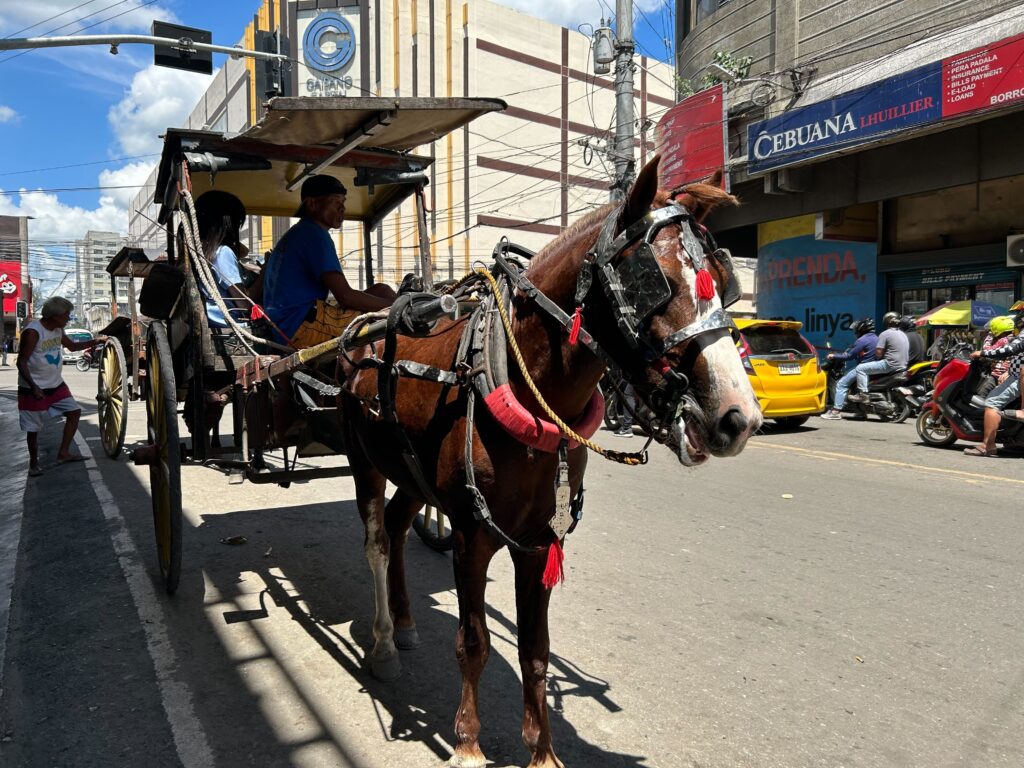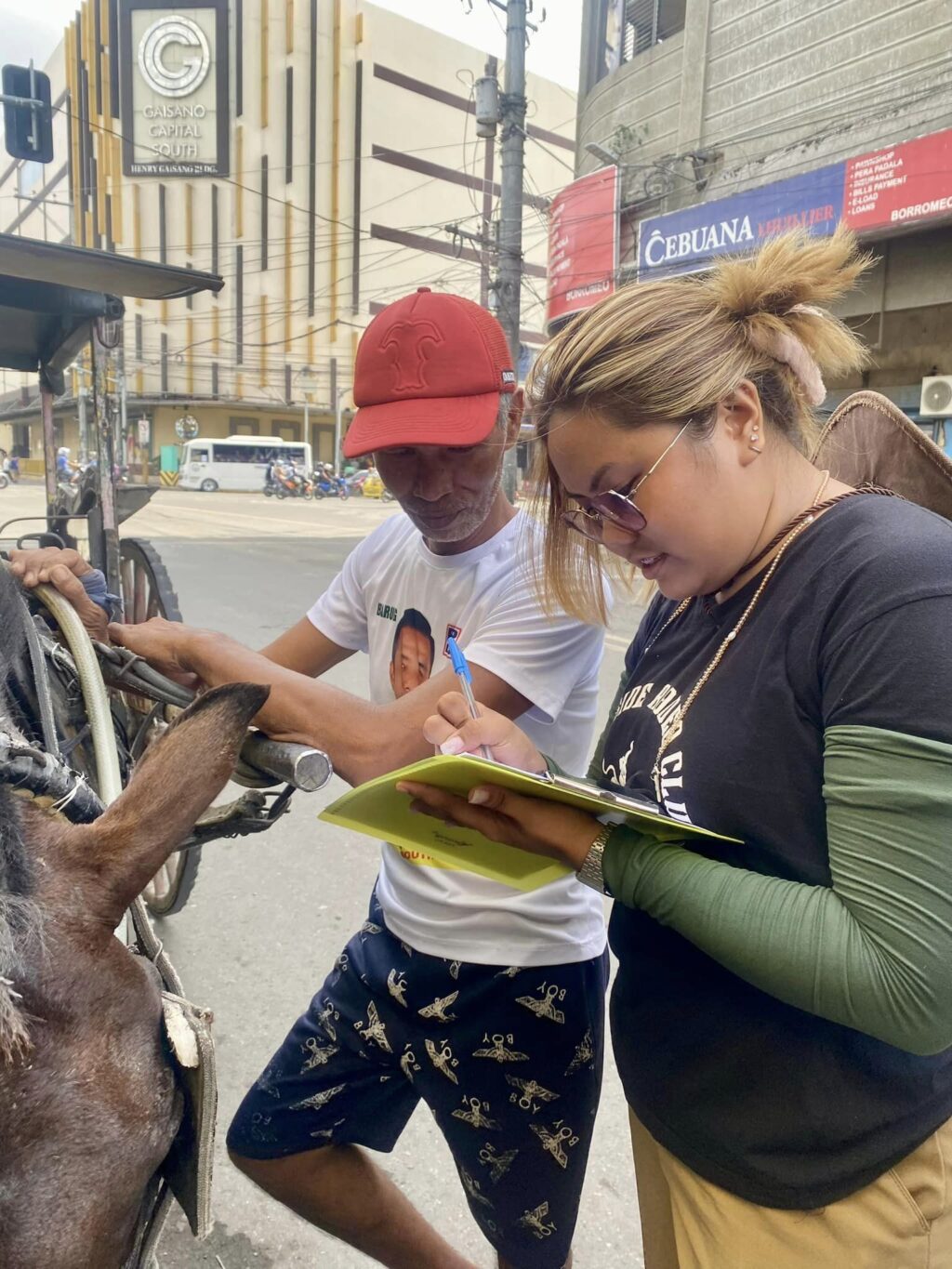A day in the life of a kutsero to city vet’s take on this traditional ride in downtown Cebu City
CEBU CITY, Philippines – Amid the honking of horns, the sounds of engines of vehicles passing by this downtown Cebu City street, another familiar sound can be heard every now and then, the jingle jangle of chains and the tick tock, tick tock sound of hooves beating the pavement.
This is Leon Kilat Street, one of Cebu City’s streets where one can ride this traditional mode of transportation that has survived through the ages — the tartanilla, which is the Cebuano term for basically a horse-drawn two-wheeled carriage.
These carriages due to their great cost then were reserved for wealthy families and high-ranking officials back then in the 1800s, but today, these have become the daily choice of transport for passengers in downtown Cebu.
For tourists and some locals, however, they just wanted to experience riding these horse-drawn carriages that used to be exclusive mode of transport for well-heeled families then.
With the gentle sway of the carriage and the rhythmic sound of the hooves of the horse beating on the pavement, they can even see themselves transported to that bygone era, where the sights, sounds, and sensations of the city take on a new, magical dimension, the time when Spaniards ruled the country.
However, with the arrival of the motorized vehicles in the Philippines, the number of tartanillas on the road declined.
Today, many believe that these traditional carriages are no longer relevant and efficient as a mode of transportation.

This is just one of the 30 plus “tartanillas” cruising downtown Cebu.
But not to Dioscoro Enanorya –and Ging Gong, the horse.
Meet Kuya ‘Diosy,’ a 66-year-old ‘kutsero’ who has been braving the car-dominated streets as a coachman for 49 years.
Kuya Diosy’s passion for tartanillas began at a young age. He started operating one at just 17 years old.
Despite his love for learning, he was forced to drop out of school due to financial difficulties. But even in the face of adversity, Kuya Diosy refused to give up on his dreams. As a boy, he had always dreamed of becoming a soldier, but the harsh reality of poverty made that goal seem impossibly out of reach.
Instead, he turned to the tartanilla – not just as a means of making a living, but as a way to honor the traditions of his ancestors, and to keep alive the stories of the Philippines’ rich cultural heritage.
For Kuya Diosy, the tartanilla represents not just a mode of transportation, but a way of life. It helped him sustain a living for almost 50 years now.
Every single day, rain or shine, Kuya Diosy would park his trusty tartanilla along Leon Kilat at precisely noon.
He is a man on a mission — shuttling passengers from Leon Kilat to Pasil and back again, with, perhaps, an unwavering determination etched on his weather-beaten face.
Despite the sheer exhaustion that comes with braving the sweltering heat or raging rainstorms, Kuya Diosy remains resolute in his daily routine.
With every ride, Kuya Diosy earns between 700 pesos to 1000 pesos, with just a little extra cash with him after paying 550 pesos daily for horse rent.
But he is not complaining because for him, it’s not just about making a profit.
He welcomes taking on the responsibility of caring for his beloved horse, Ging Gong, with utmost pride, making sure to supply his every need, from food to horseshoes.
After all, the horse is an integral part of his livelihood, and he treats it with the same respect that he gives his human passengers.
The daily grind for Kuya Diosy begins long before his noon start time. He wakes up at 4 a.m. to gather fodder or “kumpay” for Ging Gong’s meals.
With his workday lasting until late in the evening, he knows that a well-nourished horse is a healthy horse and an essential component of his everyday operations.

One of the horses patiently waiting for passengers.
And it’s not just Kuya Diosy who cares for Ging Gong.
Every year, the Cebu City Veterinary Authority initiates a check-up for horses like Ging Gong, providing free vitamins and making sure that there are no traces of rough handling or abuse.
Contrary to the beliefs of most Cebuanos where horse-drawn carriages locally known as “tartanillas” are slowly losing their effectivity as a mode of transportation in this modern world, the head of the Cebu City Department of Veterinary Medicine and Fisheries, Dr. Jessica Maribojoc, says otherwise.
“Actually, effective pa siya [as mode of transporation] kay naa pa ma’y matawag nato nga mga pasahero nga didto pa moduol sa atong mga tartanillas,” she said in an interview with CDN Digital.
(Actually, it is still effective [as a mode of transportation] because we still have what we call passengers who would ride the tartanillas.)
Maribojoc said that tartanillas were still very useful in Cebu City, especially to the community where their routes were allowed to travel.
It may seem that this mode of transportation is slowly diminishing, but Maribojoc together with the Cebu City government is confident that in time “kutseros” and their tartanillas will be properly regulated and will be assisted with their needs.
“Naa’y proposal actually nga ang city especially sa leadership ni mayor nga kana sila is mahulog gyud na sila as transportation puhon kay kana nga area himoon mana og heritage, labi na ang city hall, from that area hangtod didto sa Colon. Kana siya plano pa na siya,” she said.
(There is actually a proposal that the city especially under the leadership of the mayor that all of them will fall as transportation in the future because that area will be made into a heritage site, especially city hall, from that area until Colon (Street). That is still a plan though.)
“In the coming years, dako pa gyud na sila’g tabang diha [labi] na sa atong mga kutsero. Effective pa gyud siya,” she further said.
(In the coming years, they are still a big help there [especially] our kutseros. They are still effective.)
In their recent visit to the area where “tartanillas” are situated in downtown Cebu, Maribojoc, said they recorded only 34 tartanillas, much less than the previous years.
The Cebu City Veterinary’s office conducts twice a year visits to “kutseros” and their “tartanillas” to ensure the health of the horses.
Monitoring includes veterinary care and veterinary surveillance.
Veterinary care is where they give vitamins to the horses, check their physical appearance for legions, rash and their hooves to give them the right kind of treatment to avoid getting infected.
Veterinary surveillance, on the other hand, is when they get blood samples from the horses to thoroughly check their health through blood checks to find out if the horses are fit for work.

Staff from DVMF- Cebu City conducting veterinary surveillance.
According to Maribojoc, they are working closely to add the grooming services for these horses as part of their scheduled checkups once they have enough funds and when the ordinance comes into play.
“Grooming inlcudes the cutting of the mane— maintaining the hooves, kung sa tao pa nagpedicure ta. Sa ilaha dapat i-control sa pagtubo and kana siya (kay) kung masobraan na siya sakit sad na siya sa part sad sa kabayo,” she said.
(Grooming includes the cutting of the mane — maintaining the hooves, if it’s a person, he or she will have pedicure. For their part, that growth [on part of the hooves] should be controlled and that one if it will grow further would be painful on the part of the horse.)
There are three challenges cited by Maribojoc in ensuring the safety and health of the “kutseros” and their horses.
First on the list is hooves shoes, they are having difficulty in sourcing a tinsmith to make these for the horses in Cebu City.
Second, is the registration of the horses.
Third, they have gotten reports about tartanillas going past their designated routes.
“Problema gyud nila karon, ginaadvice-an na nato sila nga i-trim nila ang ilahang hooves ug ang ilis-ilisan ang ilahang hooves shoes, ang tawag nato ana,” she said.
(Their problem now and we have given them advice that they should trim the hooves and change every now and then the hooves shoes, and that is what we call them.)
“Unfortunately, wala na’y mohimo. Mao to’y base nato sa ilahang testimonial nga last nga pagadto nato sa ilaha,” Maribojoc said.
(Unfortunately, they did not do that. We based that on their testimonial the last time we visited them.)
“Registration sa kabayo. Dapat magparegister gyud sila aron maregulate nato— para kaaya-aya sad siya tanawn labi na sa atong mga turista. Mao na among giconsider karon gyud nga problem labi na sa atong tartanilla sa siyudad sa Sugbo,” said Maribojoc.
(Registration of the horse. They should register their horse so that we can regulate them — so that they will look good especially to the tourists. That is what we consider now as a problem especially of our tartanillas here in Cebu City.)
Many would say that the horses we see on the streets are weak and unhealthy because of how they look and how their carriages also look
Animal advocates can rest with the thought that with the help of the Cebu City Veterinary Office, these horses are in good condition.
She said that they had been doing the rounds with the kutseros and telling them how they could take care of their horses.
Horses should ideally be fed at least twice a day with either leaves, “kopras” or a mixture of both commerical feeds and should have at least 10 pails of water a day.
In a day, a horse should only work for four hours and if possible should not be exposed to the heat of the sun for too long because this can cause exhaustion of the animal. And this would eventually impact the livelihood of its master, the kutsero.
As for the whipping of the horses, Maribojoc said that they had been reminding kutseros of the disadvantage of whipping the horse harder.
If they whip too hard, the horses may wild out and it would be hard for the kutseros to control their behavior. And if they do it too often, horses may not follow this commanding gesture from their master.
Whipping lightly, helps the kutseros to signal their horses to move at a certain pace, and according to Maribojoc, most of the kutseros are aware of how they should whip their horses to follow their commands.
“So, dili sila angay mabalaka ang katong mga animal welfare advocate kay actually isa na siya sa atong gibantayan,” Maribojoc said.
(So, the animal welfare advocate should not be concerned because that is actually what we are monitoring closely.)
“Ilabi na sa Cebu City government nga ginamonitor gyud na nato ang mga kahayopan nato, including that one because they are the ones nga usa sa mga working animals nato dinhi,” she said.
(Especially the Cebu City government, where we have been monitoring our animals, including that one because they are the ones, which are one of our working animals here.)
Cebu City, in embracing the modern world, has also managed to embrace its past, keeping the tartanilla as a symbol of heritage, culture, and community.
The harmonious coexistence of tradition and progress is an achievement worth noting, one that allows both the city and its cherished kutseros to thrive for generations to come.